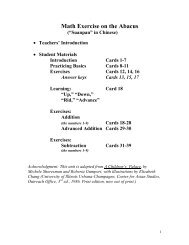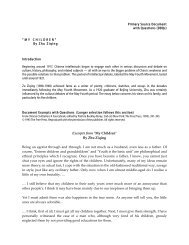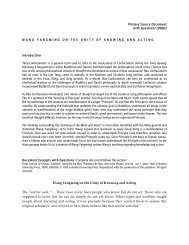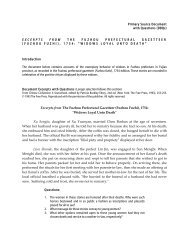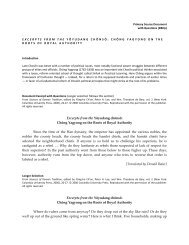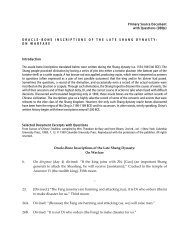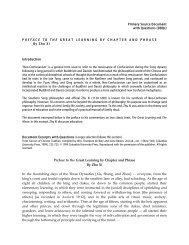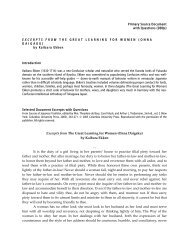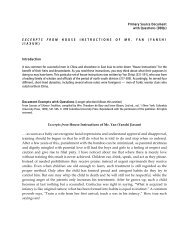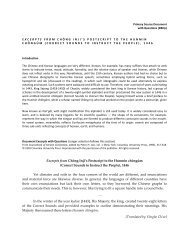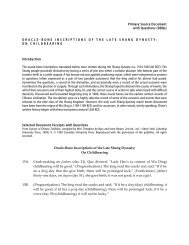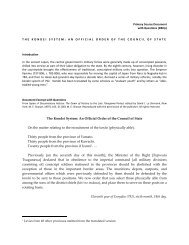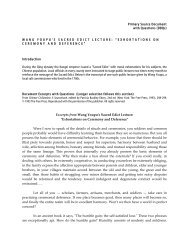I CANNOT DO OTHERWISE - Asia for Educators - Columbia University
I CANNOT DO OTHERWISE - Asia for Educators - Columbia University
I CANNOT DO OTHERWISE - Asia for Educators - Columbia University
Create successful ePaper yourself
Turn your PDF publications into a flip-book with our unique Google optimized e-Paper software.
Prim ar y S our ce Doc um e nt<br />
wi t h Qu e st io n s ( D BQ s)<br />
I C A N N O T D O O T H E R W I S E ( B U D E Y I )<br />
B y Y a n g G u a n g x i a n <br />
Int rod uct io n<br />
Beginning in late sixteenth century, Portuguese merchants began coming to trade in southern China, bringing Jesuit<br />
priests along with them. Jesuits, notably the Italian Matteo Ricci (1552-1610), aimed to convert members of the<br />
scholar-official elite who, they hoped, would then assist in spreading their religion among the people. While<br />
welcomed by the late Ming and early Qing emperors <strong>for</strong> their expertise in areas such as astronomy, calendar-making,<br />
cannon and other firearms, and mathematics, the Jesuits made relatively few converts. By the late seventeenth<br />
century, Christianity faced growing opposition among the officials and from the imperial government.<br />
The following document concerning Christianity was written by the scholar and official Yang Guangxian (1597-1669)<br />
and is part of a series of essays denouncing Christianity written between 1659 and 1665.<br />
Docu m e n t E xc erpt s w it h Q ue s tio n s (Longer selection follows this section)<br />
From Sources of Chinese Tradition: From 1600 Through the Twentieth Century, compiled by Wm. Theodore de Bary and Richard<br />
Lufrano, 2nd ed., vol. 2 (New York: <strong>Columbia</strong> <strong>University</strong> Press, 2000), 151-152. © 2000 <strong>Columbia</strong> <strong>University</strong> Press. Reproduced<br />
with the permission of the publisher. All rights reserved.<br />
I Cannot Do Otherwise (Budeyi) <br />
By Yang Guangxian <br />
<br />
… according to a book by [the Christian scholar] Li Zubo, 1 the Qing dynasty is nothing but an <br />
offshoot of Judea; our ancient Chinese rulers, sages, and teachers were but the offshoots of a <br />
heterodox sect; and our classics and the teachings of the sages propounded generation after <br />
generation are no more than the remnants of a heterodox teaching. How can one abide by these <br />
calumnies! … <br />
<br />
Our Confucian teaching is based on the Five Relationships (between parent and child, ruler and <br />
minister, husband and wife, older and younger brothers, and friends), whilst the Lord of <br />
Heaven Jesus was crucified because he plotted against his own country, showing that he did not <br />
recognize the relationship between ruler and subject. Mary, the mother of Jesus, had a husband <br />
names Joseph, but she said Jesus was not conceived by him. <br />
<br />
1 Li Zubo, Tianxue quankai (A Summary of the Propagation of Christianity, 1665).
Prim ar y S our ce Doc um e nt , wit h Qu e st io n s (D B Q) o n<br />
I C A NN O T D O O TH ER W ISE ( BU DEYI) , BY Y AN G GU A NG XI A N<br />
Q ue st io n s:<br />
1. On what grounds does Yang Guangxian criticize Christianity<br />
2. How do Yang’s arguments against Christianity compare to earlier Neo-<br />
Confucian arguments against Buddhism (as exemplified in Han Yu’s<br />
“Memorial on the Bone of the Buddha”)<br />
3. How would the Chinese Christian Zhang Xingyao rebut Yang’s arguments<br />
Lo n g er S e le cti o n<br />
From Sources of Chinese Tradition: From 1600 Through the Twentieth Century, compiled by Wm. Theodore de Bary and Richard<br />
Lufrano, 2nd ed., vol. 2 (New York: <strong>Columbia</strong> <strong>University</strong> Press, 2000), 151-152. © 2000 <strong>Columbia</strong> <strong>University</strong> Press. Reproduced<br />
with the permission of the publisher. All rights reserved.<br />
I Cannot Do Otherwise (Budeyi) <br />
By Yang Guangxian <br />
<br />
In [the Jesuit Father] Adam Schall’s own preface one can read that [the Christian scholars] Xu <br />
Guangqi and Li Zhizao both understood that they could not dare publicly to give offense to <br />
Confucian norms. Adam Schall’s work says that one man and one woman were created as the <br />
first ancestors of all humankind. He was not actually so bold as to make the contemptuous <br />
assertion that all the peoples in the world are offshoots of his teaching, but according to a book <br />
by [the Christian scholar] Li Zubo, 2 the Qing dynasty is nothing but an offshoot of Judea; our <br />
ancient Chinese rulers, sages, and teachers were but the offshoots of a heterodox sect; and our <br />
classics and the teachings of the sages propounded generation after generation are no more than <br />
the remnants of a heterodox teaching. How can we abide these calumnies! They really aim to <br />
inveigle the people of the Qing into rebelling against the Qing and following this heterodox <br />
sect, which would lead all‐under‐Heaven to abandon respect <strong>for</strong> rulers and fathers. … <br />
<br />
Our Confucian teaching is based on the Five Relationships (between parent and child, ruler and <br />
minister, husband and wife, older and younger brothers, and friends), whilst the Lord of <br />
Heaven Jesus was crucified because he plotted against his own country, showing that he did not <br />
recognize the relationship between ruler and subject. Mary, the mother of Jesus, had a husband <br />
named Joseph, but she said Jesus was not conceived by him. <br />
<br />
Those who follow this teaching [Christianity] are not allowed to worship their ancestors and <br />
ancestral tablets. They do not recognize the relationship of parent and child. Their teachers <br />
oppose the Buddhists and Daoists, who do recognize the relationship between ruler and subject <br />
and father and son. Jesus did not recognize the relationship between ruler and subject and <br />
parent and child, and yet the Christians speak of him as recognizing these relationships. What <br />
arrant nonsense! … <br />
<br />
2 See footnote 1, above. <br />
As ia fo r E du cat ors | Colu m bia U niv ers it y | ht t p:/ /af e. ea s ia.colu m bia. e du Page 2 of 3
Prim ar y S our ce Doc um e nt , wit h Qu e st io n s (D B Q) o n<br />
I C A NN O T D O O TH ER W ISE ( BU DEYI) , BY Y AN G GU A NG XI A N<br />
[The Jesuit Father] M. Ricci wished to honor Jesus as the Lord of Heaven (Tianzhu) who leads <br />
the multitude of nations and sages from above, and he particularly honored him by citing <br />
references to the Lord‐on‐High (Shangdi) in the Six Classics of China, quoting passages out of <br />
context to prove that Jesus was the Lord of Heaven. He said that the Lord of Heaven was <br />
referred to in the ancient classical works as the Lord‐on‐High, and what we in the west call “the <br />
Lord of Heaven” is what the Chinese have spoken of as “the Lord‐on‐High.” [According to <br />
Ricci] the Heaven (Tian) of the blue sky functions as a servant of the Lord‐on‐High, which is <br />
located neither in the east nor in the west, lacks a head or stomach, has no hands or feet, and is <br />
unable to be honored. How much less would earthbound land, which a multitude of feet <br />
trample and defile, be considered something to be revered Thus Heaven and Earth are not at <br />
all to be revered. Those who argue like this are no more than beasts able to speak a human <br />
language. <br />
<br />
Heaven is the great origin of all events, things, and principles. When principles a (li) are <br />
established, material‐<strong>for</strong>ce (qi) comes into existence. Then, in turn, numbers are created and <br />
from these numbers, images begin to take <strong>for</strong>m. Heaven is Principle within <strong>for</strong>m, and Principle <br />
is Heaven without <strong>for</strong>m. When shape comes in to its utmost <strong>for</strong>m, then Principle appears <br />
therein; this is why Heaven is Principle. Heaven contains all events and things, while Principle <br />
also contains all events and things and, as a result, when one seeks the origin of things in the <br />
Supreme Ultimate (Taiji) it is only what we call Principle. Beyond principle there is no other <br />
principle, and beyond Heaven there is no other Heaven [i.e., Lord of Heaven]. <br />
<br />
As ia fo r E du cat ors | Colu m bia U niv ers it y | ht t p:/ /af e. ea s ia.colu m bia. e du Page 3 of 3



